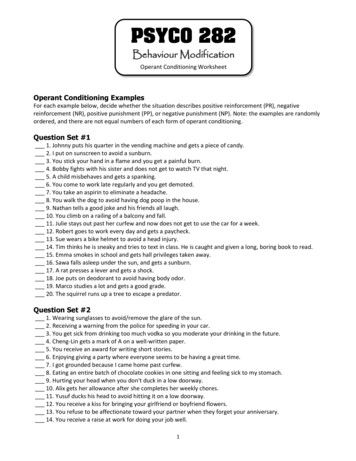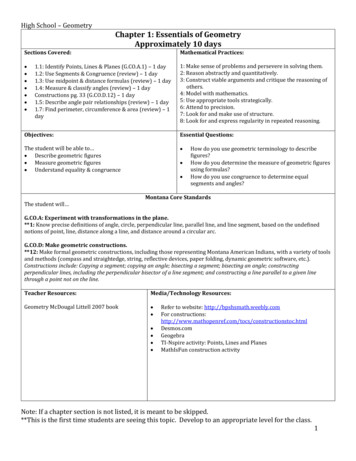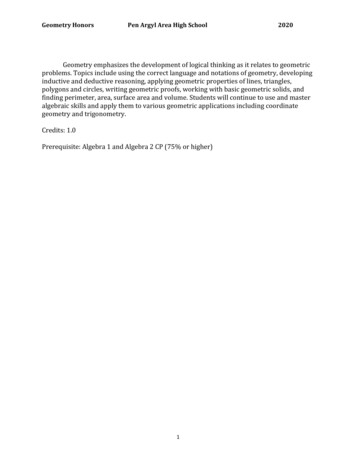
Transcription
High School Geometry Worksheet Bundle:Volume TwoPrintable math worksheets from Edmentum's Study Island.
Geometry: Transformations in the Plane1. What is the rule for a reflection across the y-axis?A. (x' , y') (-x , y)B. (x' , y') (x , -y)C. (x' , y') (y , x)D. (x' , y') (-x , -y)2. Which of the following transformations will produce a similar, but not congruent figure?A. rotationB. reflectionC. dilationD. translation3.What is the rule for the transformation from the larger polygon to the smaller polygon?A.B.C.D.Geometry: Transformations in the PlaneCopyright 2020 Edmentum - All rights reserved.
4.What is the rule for the transformation above?A. (x' , y') (x 1 , -y - 4)B. (x ', y') (-2x 1 , 2y 4)C. (x' , y') (-x - 1 , y - 4)D. (x' , y') (2x 7 , 2y - 5)5.If figure QRST is reflected across the x-axis and then translated 3 units down, which of the following willbe the coordinates for point R'?A. (0,5)B. (3,-2)C. (-3,2)D. (-3,5)Geometry: Transformations in the PlaneCopyright 2020 Edmentum - All rights reserved.
6.What is the rule for the transformation shown above?A. (x' , y') (x 4 , y 4)B. (x' , y') (x - 4 , y - 4)C. (x' , y') (x - 8 , y - 8)D. (x' , y') (x 8 , y 8)7.R(-4,-1)R'(-1,3)S(-6,3)S'(-3,7)Given the points above, which of the following transformations maps RS to R'S'?A. translate horizontally 3 units and vertically -4 unitsB. translate horizontally -3 units and vertically -4 unitsC. translate horizontally -3 units and vertically 4 unitsD. translate horizontally 3 units and vertically 4 unitsGeometry: Transformations in the PlaneCopyright 2020 Edmentum - All rights reserved.
8.What is the rule for the transformation shown above?A. (x' , y') (y , x)B. (x' , y') (y , -x)C. (x' , y') (-y , x)D. (x' , y') (-x , -y)9.What are the coordinates of C' if A'B'C'D'E'F'G' is a reflection of ABCDEFG across the y-axis?A. (-4,6)B. (4,-2)C. (-2,4)D. (-4,2)Geometry: Transformations in the PlaneCopyright 2020 Edmentum - All rights reserved.
10. The parallelogram ABCD is shown below.If the parallelogram is translated so that A is mapped to A', then what will be the coordinates of C'?A. (1,-1)B. (-2,2)C. (2,-2)D. (2,-1)Geometry: Transformations in the PlaneCopyright 2020 Edmentum - All rights reserved.
Answers: Transformations in the Plane1. A2. C3. A4. D5. C6. D7. D8. B9. D10. CExplanations1. In a reflection across the y-axis, for each point of the polygon, the x-value changes sign while the yvalue stays the same.Thus x' -x and y' y.2. Two figures are congruent if they have corresponding angles of equal measure and sides of equalmeasure. A dilation is a transformation which transforms each line to a parallel line whose length is afixed multiple of the length of the original line. Since a dilation does not keep the lengths of the sides thesame, figures obtained by dilation are similar, and not congruent.3. Notice that both figures have the same shape and orientation, but they have different sizes.A dilation is the only type of transformation that produces a change in size.Choose a point on the larger polygon, such as (2, 4). Then, find the corresponding point, after the objecthas been translated, on the smaller polygon.The point (2, 4) on the larger polygon corresponds to the point (1, 2) on the smaller polygon.Thus, the values of the x- and y-coordinates were both halved during the transformation. Therefore, thefollowing is true.So, the rule for the transformation is shown below.4. The transformation shows a dilation and a translation. The transformation can be written in twodifferent ways, one in which the dilation is done first and one in which the translation is done first. In thisGeometry: Transformations in the PlaneCopyright 2020 Edmentum - All rights reserved.
explanation of the transformation, the dilation is done first.Start by determining the scale factor of the dilation. The length of the bottom of the original polygon is3 units. The length of the bottom of the translated polygon is 6 units. So, the scale factor is two and (x' , y') (2x , 2y).Now, choose a point on the original polygon, such as (-1 , 1). Then, find the corresponding point after adilation with a scale factor of two.So, the point (-1 , 1) should be at point (-2 , 2) after the dilation. Now, determine the translation needed toget from the dilated point (-2 , 2) to its final resting place at the point (5 , -3). The translation can be foundby subtracting the dilated coordinates from the final coordinates.For x: 5 - (-2) 7.For y: -3 - 2 -5.So, the rule for the translation after the dilation is (x' , y') (x 7 , y - 5).The combined transformation for both operations (dilation and translation) is (x' , y') (2x 7 , 2y - 5).5. When point P(x,y) is reflected across the x-axis and translated 3 units down, the translation point, P', islocated at (x,-y - 3), where the y-coordinate changes signs and 3 units are subtracted from the ycoordinate to move down. The x-coordinate remains the same.Thus, the coordinates of point R reflected across the x-axis and translated 3 units down are R'(-3,2).6. Choose a corner of the object, such as (-4 , -2). Then see what point that corner is on after the objecthas been translated.The corner on point (-4 , -2) is on point (4 , 6) after the translation.The object moved 8 units horizontally on the x-axis (the 8 is positive since it moved to the right on the xaxis). Therefore, x' x 8.It also moved 8 units vertically on the y-axis (the 8 is positive since it moved up the y-axis). Therefore, y' Geometry: Transformations in the PlaneCopyright 2020 Edmentum - All rights reserved.
y 8.So, the rule for the transformation is (x' , y') (x 8 , y 8).7. The point R (-4,-1) maps to R' (-1,3).So, R is shifted 3 units horizontally on the x-axis and is shifted 4 units vertically on the y-axis.Therefore, (x',y') (x 3,y 4) which indicates the map translated horizontally 3 units and vertically4 units.8. For any given angle,the following., the new coordinates for a counterclockwise rotation about the origin ofis(x' , y') (x cos - y sin , x sin y cos )The polygon has been transformed by a counterclockwise rotation of 270 about the origin.(x' , y') (x cos 270 - y sin 270 , x sin 270 y cos 270 ) (x(0) - y(-1) , x(-1) y(0)) (y , -x)9. When point P(x,y) is reflected over the y-axis, the point P' is located at (-x,y), where only the sign of thex-coordinate changes.Thus, the coordinates of the reflection across the y-axis of point C are C'(-4,2).10. The point A at (-1,4) is mapped to point A' at (-6,-3).The change in the x-coordinate is -6 - (-1) -5 or 5 units to the left.The change in the y-coordinate is -3 - 4 -7 or 7 units down.Next, find C'. The coordinates of C are at (7,5). Shifting the x-coordinate 5 units to the left gives, x' 7 - 5 2. Shifting the y-coordinate 7 units down gives, y' 5 - 7 -2.So, the coordinates of C' are (2,-2).Geometry: Transformations in the PlaneCopyright 2020 Edmentum - All rights reserved.
Geometry: Geometric Constructions1. Below is a stage in the construction of a bisector ofABC.Which of the following describes the next step in the construction?A. Draw an arc intersectingcentered at point D using any compass width.B. Draw an arc intersectingcentered at point E using any compass width.C.Draw intersecting arcs within the interior ofcompass width.ABC from points D and E without changing theD. Set the compass width to the distance between points D and E.2. What is the first step to construct a line parallel toa compass and a straightedge?A. Draw a line through point C that intersectsB.passing through an external point C, using onlyand mark the point of intersection.Place the compass needle on point C and using sufficient compass width mark two arcs across.C. Place the compass needle at any point onand set the compass width to point C.D. Make two arcs through point C centered at points A and B.Geometry: Geometric ConstructionsCopyright 2020 Edmentum - All rights reserved.
3. When Jackson walked into Geometry class, the following diagram was on the chalk board.Which of the following constructions has a step that would involve this diagram?A. construction of a line parallel to a given lineB. construction of a perpendicular bisectorC. construction of a perpendicular to a line through a point not on the lineD. construction of a perpendicular to a line through a point on the line4. Sally used a ruler to draw the segment AB. She then opened her compass to the length of AB and drewa circle. Keeping the compass open to the same length, she marked off equal parts along the circle asshown in the following figure.Using some or all of the points of intersection and point A, which of the following regular polygons couldshe construct?A. hexagonB. decagonC. pentagonD. squareGeometry: Geometric ConstructionsCopyright 2020 Edmentum - All rights reserved.
5. GivenABC below, which would be the next step when constructing the bisector ofW.X.Y.Z.ABC?A. WB. YC. XD. Z6. To copy an angle using only a compass and a straightedge, begin by marking the vertex of the newangle. Then, draw a ray from the vertex, which will be one of the legs of the new angle. What is the nextstep in the construction?A.Place the compass needle at any point on the leg of the new angle, set the compass width to thevertex of the angle, and make an arc in the angle's interior.B.Place the compass needle on one of the legs of the original angle, and draw an arc on the leg of thenew angle using a convenient compass width.C.Set the compass to a convenient width and draw an arc from the vertex of the original angleintersecting both legs of the original angle.D.Place the compass needle on one of the legs of the original angle and draw an arc on the other legof the angle using sufficient compass width.Geometry: Geometric ConstructionsCopyright 2020 Edmentum - All rights reserved.
7. Line CD is constructed by making arcs centered at point A and point B with the same compass width.Which of the following equations is not necessarily true?A. AB CDB. AE EBC. AD DBD. AC CB8. Sally used a ruler to draw the segment AB. She then opened her compass to the length of AB and drewa circle. Keeping the compass open to the same length, she marked off equal parts along the circle asshown in the following figure.Using some or all of the points of intersection and point A, which of the following regular polygons couldshe construct?A. squareB. pentagonC. decagonD. equilateral triangleGeometry: Geometric ConstructionsCopyright 2020 Edmentum - All rights reserved.
9. The figure below illustrates constructing .A. a bisector of an angleB. a congruent angleC. a right angleD. an obtuse angle10. Brian used a ruler to draw the segment AB. He then constructed a bisector of AB and used it to createanother diameter as shown in the following figure.Using the points of intersection of the circle and the diameters, which of the following regular polygonscould be formed?A. hexagonB. equilateral triangleC. pentagonD. squareGeometry: Geometric ConstructionsCopyright 2020 Edmentum - All rights reserved.
Answers: Geometric Constructions1. C2. A3. C4. A5. A6. C7. A8. D9. B10. DExplanations1. The steps for constructing the bisector of an angle using only a compass and a straightedge are showbelow.1. Place the compass needle on the vertex of ABC.2. Set the compass to any convenient width.3. Draw an arc intersecting both rays of the angle. Mark and label the points of intersection, D andE.4. Move the compass needle to point D. If required, adjust the compass width at this point. Draw anarc within the interior of ABC.5. Without changing the width of the compass, move its needle to point E and draw another arc thatcrosses the arc drawn from point D.6. Mark the point of intersection of the arcs centered at point D and point E. Label the intersectionpoint F.7. Draw a straight line from vertex B passing through point F.8.Geometry: Geometric ConstructionsCopyright 2020 Edmentum - All rights reserved.
2. The steps for constructing a line parallel tocompass and a straightedge are show below.and passing through point C not onusing only a1. Draw a line through point C that intersects. Label the intersection of the lines point D.2. Place the compass needle on point D, and set the compass width to approximately half thedistance between points D and C. Draw an arc intersecting both lines and label the points ofintersection E and F.3. Keeping the compass width the same, place the compass needle on point C and draw an arcsimilar to the one drawn from point D. Label the point of intersection G.4. Place the compass needle on point E and set the compass width to the length of EF.5. Move the compass needle to point G and draw an arc intersecting the upper arc. Label the pointof intersection H.6. Draw a line through points C and H. Line CH is parallel to.7.3. The steps for constructing the a line perpendicular to a given line through a point not on the given lineusing only a compass and a straightedge are show below.1.2.3.4.5.Start with line m and a point A not on the line m.Place the compass needle on the external point A.Set the width of the compass to be greater than the distance from point A to line m.Draw an arc across line m on each side of point A. Label these points B and C.Set the compass needle on point B and set the width of the compass to be greater than half thelength of BC.6. From point B, make an arc on the opposite side of line m from point A.7. Without changing the compass width, make an arc from point C that intersects the arc drawnfrom point B. Label the point of intersection D.8. Draw a line through points A and D.is perpendicular to line m at point E.Geometry: Geometric ConstructionsCopyright 2020 Edmentum - All rights reserved.
9.So, the diagram that was on the chalk board is from the construction of a perpendicular to a linethrough a point not on the line.4. Connecting all points of intersection will form a regular hexagon as shown in the following figure.5. The next step in the bisection of ABC would be to place the compass on point C and draw an arc inthe middle of the angle. Then, move the compass to point A and draw the same arc so that it intersectedthe first one.This is illustrated by choice W.Geometry: Geometric ConstructionsCopyright 2020 Edmentum - All rights reserved.
6. The steps for constructing the copy of an angle using only a compass and a straightedge are showbelow.1. Mark the point that will be the vertex of the new angle and label it point E.2. Draw a ray from point E in any direction, with any length. This ray will be one of the sides of thenew angle.3. Place the compass needle on the vertex of the original angle and adjust the width of the compassto a convenient size.4. Use the compass to draw an arc intersecting both rays of the original angle at two points, H and J.5. Move the compass (without changing the width) to point E and make an arc intersecting theexisting ray of the angle. Mark the intersection point and label it point K.6. Set the compass needle on the original angle at point H and set its width to the length of HJ.7. Move the compass needle to point K on the new angle and draw an arc intersecting the previousarc. Mark the intersection point and label it point L.8. Draw a ray from point E through point L.9.7. The construction described in the problem follows that of the perpendicular bisector of AB using only acompass and a straightedge.Sinceis a perpendicular bisector of AB, AE EB.Since any point on a perpendicular bisector is equidistant from each endpoint of the line segment, AC CB and AD DB.Geometry: Geometric ConstructionsCopyright 2020 Edmentum - All rights reserved.
Since points C and D are the intersections of arcs centered at points A and B with the same width, thedistance between points C and D can be made shorter by using a smaller width of the compass or longerby using a longer width of the compass. There is one width in which AB CD, but that width is notnecessary in the construction.Therefore, the length of AB does not necessarily equal the length of CD.8. Connecting every other point will form an equilateral triangle as shown in the following figure.9. The steps for constructingABC congruent toDEF are shown below.Geometry: Geometric ConstructionsCopyright 2020 Edmentum - All rights reserved.
The last step of the construction matches the given illustration. Therefore, this is the construction of acongruent angle.10. Connecting the points of intersection of the diameters and the circle will form a square as shown inthe following figure.Geometry: Geometric ConstructionsCopyright 2020 Edmentum - All rights reserved.
Geometry: Right Triangle Trigonometry1.*Picture not drawn to scale.Triangle LMN is similar to triangle PQR. The length of PQ is twice the length of LM.If the sine of angle L is, what is the sine of angle P?A.B.C.D.Geometry: Right Triangle TrigonometryCopyright 2020 Edmentum - All rights reserved.
2. Angles A and B are complementary angles in a right triangle. The value of cos(A) is . What is the valueof sin(A)?A.B.C.D.3. Which of the following functions is equal to cos(90 A. tan(90 B. sec())C. csc(90 D. sin()?))4. Which of the following functions is equal to sin(76 )?A. cos(14 )B. csc(76 )C. csc(14 )D. cos(76 )Geometry: Right Triangle TrigonometryCopyright 2020 Edmentum - All rights reserved.
5.Note: Picture is not drawn to scale.If X 9 feet, Y 12 feet, and Z 15 feet, what is the cosine ofB?A.B.C.D.6.Two wires are attached to a pole and create similar triangles with the ground. The longer wire is attachedto the ground 32 feet from the base of the pole and the shorter wire is attached to the ground 16 feetfrom the base of the pole.If the cosine of the angle formed by the shorter wire and the ground islonger wire?, what is the length of theA. 164 feetB. 246 feetC. 123 feetD. 82 feetGeometry: Right Triangle TrigonometryCopyright 2020 Edmentum - All rights reserved.
7. An apple that was 4 meters off the ground was blown off a tree. The angle between the final positionof the apple and the original position of the apple was 35 .Note: picture not drawn to scaleWhich equation can be used to find the horizontal distance, r, that the apple was displaced?A.B.C.D.Geometry: Right Triangle TrigonometryCopyright 2020 Edmentum - All rights reserved.
8.Amy is standing 65 meters from the base of the Washington Monument in Washington, DC. Sheestimates that the angle of elevation to the top of the building is 60 . One of her friends is at the top ofthe building. What is the distance between Amy and her friend? (Assume the monument meets theground at a right angle.)A. 113 metersB. 75 metersC. 33 metersD. 130 meters9.If 65 and h 5 mm, what is the value of k to the nearest tenth of a millimeter?A. 11.8 mmB. 10.7 mmC. 5.5 mmD. 11.3 mmGeometry: Right Triangle TrigonometryCopyright 2020 Edmentum - All rights reserved.
10.An engineer wants to build a bridge across a gorge as shown in the figure above. To calculate the lengththe bridge will need to be, L, she chooses two points directly across the gorge from each other to formone side of a right triangle and then another point that is 20 m apart from one of the first points to makethe other side of the right triangle. She calculates the angle opposite the longer side to be 60 .What is the distance across the gorge, L? Round to the nearest hundredth of a meter.A. 34.64 mB. 40 mC. 10 mD. 17.32 mGeometry: Right Triangle TrigonometryCopyright 2020 Edmentum - All rights reserved.
Answers: Right Triangle Trigonometry1. D2. B3. D4. A5. D6. A7. D8. D9. A10. AExplanations1. The trigonometry ratios of similar triangles are equivalent for corresponding angles.Since angle L corresponds to angle P, the sine of angle L is equal to the sine of angle P.So, the sine of angle P is.2. Given a right triangle with complementary angles A and B, the following is true.In this problem, cos(A) . Use the following ratio to find sin(A).Apply the Pythagorean theorem to find the value of the hypotenuse, then use the trignometric ratios tosolve for sin(A).The value of the hypotenuse was given in the problem, and the value of the opposite side was solved for;therefore, sin(A) .3. The co-functions of complementary angles are equal. Ifrelationship is true.is an acute angle, then the followingGeometry: Right Triangle TrigonometryCopyright 2020 Edmentum - All rights reserved.
cos(90 -) sin(4. The co-functions of complementary angles are equal. Ifrelationship is true.)is an acute angle, then the followingSubtract 76 from 90 to find the complementary angle of 76 .Therefore, sin(76 ) cos(14 ).5. In the right triangle, the cosine ofB is the ratio of the side adjacentB to the hypotenuse.6. The trigonometric ratios of similar triangles are equivalent.The cosine of the angle formed by the shorter wire and the ground is.So, the cosine of the angle formed by the longer wire and the ground is also.Use this fact to find the length of the longer wire, x.So, the length of the longer wire is 164 feet.7. Since the angle between the final and the original positions of the apple, and the distance the apple fellare known, the tangent equation should be used.8. Letbe the angle of elevation in the right triangle. Therefore, the following is true.Geometry: Right Triangle TrigonometryCopyright 2020 Edmentum - All rights reserved.
The question gives that the hypotenuse represents the distance between the two friends. Label thisvariable d.It also gives that the side adjacent tois equal to 65 m and 60 .Therefore, the following is true.Now, solve for d.The friends are 130 meters apart.9. Given a right triangle and an acute angleof the right triangle, the following is true.Thus, k can be found by the following steps.10. Use the tangent function to solve for the distance.Therefore, the bridge will need to be approximately 34.64 m in length.Geometry: Right Triangle TrigonometryCopyright 2020 Edmentum - All rights reserved.
Geometry: Law of Sines and Law of Cosines1.Note: Figure not drawn to scale.In the triangle shown above, m B 49 , a 20 cm, and c 10 cm. What is the approximate length of sideb?A. 22.33 cmB. 237.58 cmC. 19.2 cmD. 15.41 cm2. The law of cosines can be proved using the Pythagorean theorem.Given triangle ABC, which statement below correctly uses the Pythagorean theorem in the proof of thelaw of cosines?A.B.C.D.a2 (b cos(A))2 (c - b cos(A))2a2 (b sin(A))2 (b cos(A))2a2 (b sin(A))2 (c b cos(A))2a2 (b sin(A))2 (c - b cos(A))2Geometry: Law of Sines & Law of CosinesCopyright 2020 Edmentum - All rights reserved.
3.Note: Figure not drawn to scale.In the triangle shown above, m A 42 , b 11 m, and c 19 m. What is the approximate length of side a?A. 13.09 mB. 21.92 mC. 171.37 mD. 18.07 m4.Note: Figure not drawn to scale.In the triangle shown above, m A 114 , m C 22 , and a 50 ft. What is the approximate length ofside b?A. 34.34 ftB. 38.02 ftC. 61.62 ftD. 1.34 ftGeometry: Law of Sines & Law of CosinesCopyright 2020 Edmentum - All rights reserved.
5.Note: Figure not drawn to scale.In the triangle shown above, a 7 m, b 14 m, and c 18 m. What is the approximate measure of angleC?A. 63.71 B. 113.77 C. 116.29 D. 134.62 6. Two forces acting on an object form a right angle. Force A is 25 pounds, force B is 60 pounds, and theresultant force is 65 pounds.What is the measure of the angle formed by the resultant force and force A? (Round to the nearestdegree.)A. 25 B. 69 C. 23 D. 67 Geometry: Law of Sines & Law of CosinesCopyright 2020 Edmentum - All rights reserved.
7.Note: Figure not drawn to scale.In the triangle shown above m A 49 , a 14 cm, and c 8 cm. What is the approximate measure ofangle C?A. 35.94 B. 25.55 C. 154.45 D. 40.16 8.Note: Figure not drawn to scale.In the triangle shown above m B 106 , m A 44 , and b 12 in. What is the approximate length ofside c?A. 8.14 inB. 23.07 inC. 3.89 inD. 6.24 in9. Two forces are acting on an object. Force X is a 36-pound force pulling upward, and force Y is a 48pound force pulling to the right.If the resultant force is 60 pounds, what is the approximate measure of the angle formed by force X andthe resultant force? (Round to the nearest degree.)A. 37 B. 53 C. 48 D. 90 Geometry: Law of Sines & Law of CosinesCopyright 2020 Edmentum - All rights reserved.
10. The law of sines states that if ABC is a triangle with sides a, b, and c, then the following is true.In order to prove the law of sines, what must first be constructed in triangle ABC?A. an altitude of triangle ABCB. a median of triangle ABCC. a perpendicular bisector of triangle ABCD. an angle bisector of triangle ABCGeometry: Law of Sines & Law of CosinesCopyright 2020 Edmentum - All rights reserved.
Answers: Law of Sines & Cosines1. D2. D3. A4. B5. B6. D7. B8. D9. B10. AExplanations1. The law of cosines states that b2 a2 c2 - 2ac cos(B).The question gives that m B 49 , a 20 cm, and c 10 cm.Evaluate the formula with the given information to find the approximate length of side b.2. The law of cosines states that if ABC is a triangle with sides a, b, and c, then the following statementsare true.Given triangle ABC, construct an altitude of the triangle. In this case, altitude CD was constructed, asshown below.Geometry: Law of Sines & Law of CosinesCopyright 2020 Edmentum - All rights reserved.
Two right triangles, ACD and BCD, were formed. From these two right triangles, the following statementscan be made.Thus, DA b cos(A), CD b sin(A), and DB c - b cos(A).Triangle BCD is a right triangle with side a as the hypotenuse. Apply the Pythagorean theorem.Since sin2(A) cos2(A) 1, the following statement is derived.Similar reasoning produces the other components of the law of cosines.3. The law of cosines states that a2 b2 c2 - 2bc cos(A).The question gives that m A 42 , b 11 m, and c 19 m.Evaluate the formula with the given information to find the approximate length of side a.Geometry: Law of Sines & Law of CosinesCopyright 2020 Edmentum - All rights reserved.
4. The law of sines states that if ABC is a triangle with sides a, b, and c, then the following is true.The question gives that m A 114 , m C 22 , and a 50 ft.First, use the given information to find the measure of angle B.m A m B m C 180 114 m B 22 180 m B 44 Apply the law of sines to solve for the length of side b.5. The law of cosines states that c2 a2 b2 - 2ab cos(C).The question gives that a 7 m, b 14 m, and c 18 m.Evaluate the formula with the given information to find the approximate measure of angle C.Geometry: Law of Sines & Law of CosinesCopyright 2020 Edmentum - All rights reserved.
6. The law of sines states that if ABC is a triangle with side lengths a, b, and c, the following statement istrue.First, sketch a picture of the forces acting on the object.The resultant force vector is the diagonal of the rectangle formed by the force A vector and the force Bvector.Note: picture not drawn to scaleNext, use the law of sines to find the measure of the angle, x, formed by the resultant force and force A.Geometry: Law of Sines & Law of CosinesCopyright 2020 Edmentum - All rights reserved.
Thus, to the nearest degree, the measure of the angle formed by the resultant force and force A is 67 .7. The law of sines states that if ABC is a triangle with sides a, b, and c, then the following is true.The question gives that m A 49 , a 14 cm, and c 8 cm.Apply the law of sines to solve for the measure of angle C.Notice that the calculations gave two possible angles between 0 and 180 . This is because sine is positivein both the first and second quadrants.Since c a, the measure of angle C must be less than the measure of angle A, which only occurs when themeasure of angle C is 25.55 .8. The law of sines states that if ABC is a triangle with sides a, b, and c, then the following is true.Geometry: Law of Sines & Law of CosinesCopyright 2020 Edmentum - All rights reserved.
The question gives that m B 106 , m A 44 , and b 12 in.First, use the given information to find the measure of angle C.m A m B m C 180 44 106 m C 180 m C 30 Next, apply the law of sines to solve for the length of side c.9. The law of cosines states that if ABC is a triangle with sides a, b, and c, the following statements aretrue.a2 b2 c2 - (2bc)cos(A)b2 a2 c2 - (2ac)cos(B)c2 a2 b2 - (2ab)cos(C)First, sketch a picture of the forces acting on the object.The resultant force vector is the diagonal of the rectangle formed by the force X vector and the force Yvector.Note: Picture is not drawn to scale.Geometry: Law of Sines & Law of CosinesCopyright 2020 Edmentum - All rights reserved.
Next, use the law of cosines to find the measure of the angle, B, formed by force X and the resultantforce.b2 a2 c2 - (2ac)cos(B)(48 pounds)2 (36 pounds)2 (60 pounds)2 - 2(36 pounds)(60 pounds)cos(B)2,304 pounds2 4,896 pounds2 - (4,320 pounds2)cos(B)(4,320 pounds2)cos(B) 2,592 pounds2cos(B) 0.6B cos-1(0.6)B53 Therefore, the approximate measure of the angle formed by force X and the resultant force is 53 .10. The law of sines states that if ABC is a triangle with sides a, b, and c, then the following is true.Given triangle ABC, construct an altitude of the triangle. In this case, altitude CD was constructed, asshown below.Two right triangles, ACD and BCD, were formed. From these two right triangles, the following statementscan be made.Thus, CD b sin(A) and CD a sin(B), which gives the following.Similar reasoning produces the other components of the law of sines.Geometry: Law of Sines & Law of CosinesCopyright 2020 Edmentum - All rights res
High School Geometry Worksheet Bundle: Volume Two Printable math worksheets from Edmentum's Study Island. Geometry: Transformations in the Plane 1. What is the rule for a reflection across the y . Geometry: Geometric Constructions . 1. Below is a stage in the construction of a bisector of ABC.










